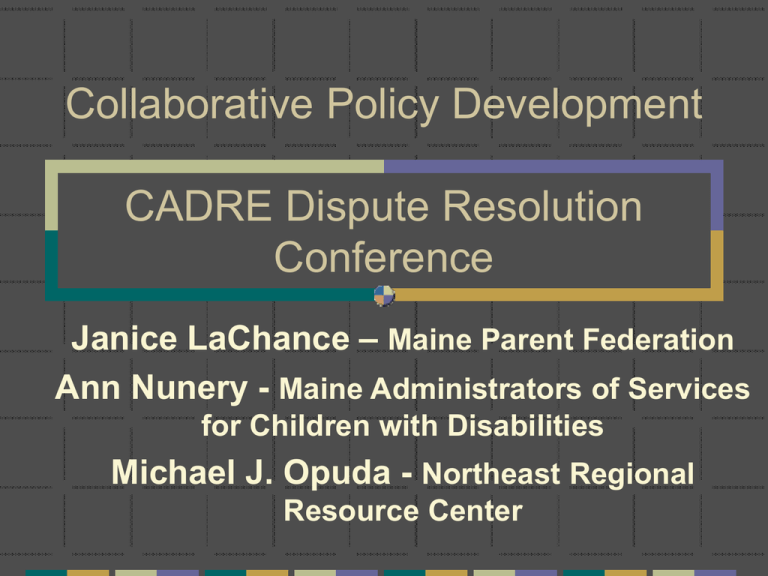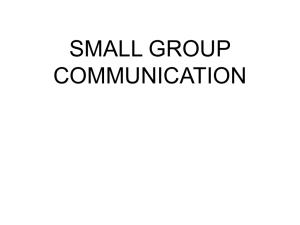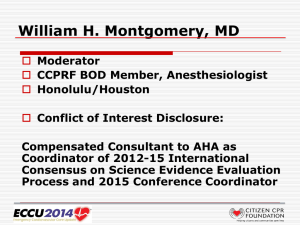Session_6_2_Stakeholders
advertisement

Collaborative Policy Development CADRE Dispute Resolution Conference Janice LaChance – Maine Parent Federation Ann Nunery - Maine Administrators of Services for Children with Disabilities Michael J. Opuda - Northeast Regional Resource Center Welcome - Dispute Resolution Stakeholders Our charge: Develop consensus for consideration by the Dept. of Ed. Issues for discussion: Mandatory mediation Barring attorneys from mediations Label for Serious Emotional Disturbance Agenda Welcome & Orientation Review ground rules Collaborative policy development Consensus building Policy Development Activity Feedback / Reflections Ice Breaker Turn to the person next to you. Identify the role you’ve been assigned for this activity Identify who you really are Why are you here? What do you want to learn today? Report out Purpose of this Stakeholders’ Meeting To identify policy options To identify significant issues of concern to stakeholders To develop consensus on policy recommendations for the Department’s consideration Objectives Improve understanding of diverse perspectives regarding the issues Open, honest discussion of the issues Identification of policy options based upon group consensus Have some fun Ground Rules Agree to commit to entire meeting Work collaboratively to develop consensus Be respectful of diverse opinions Express alternatives Avoid side conversations Others? What is Collaborative Policy Development? A Consensus based decision-making process Collaboration among interested parties Shared vision, goals, outcomes / diverse interests Alternative to traditional policy development process Typical Rulemaking Process Development proposed rule Notice of proposed rule Public hearing Public comment period Review, summarize & respond to comments Final regulations adopted Why do we have regulations? Builds on federal law, federal regulations and state law. Recognizes the regime values of Congress and the state legislature. Clarifies legal obligations and terms. Why do we have regulations? Establishes state policy. Sets standards for performance. Provides fair notice of obligations. Problems with Traditional Policy Development Accommodation / Compromise Reactive process Abstract policies Top down decision making Iron Triangles / Favored Voices Collaborative Policy Development Characteristics All groups with a stake voluntarily agree to participate There is direct, face-to-face interaction Decisions are made by consensus The group determines process and outcomes Collaborative Policy Development Benefits Focuses resources / sets priorities Ensures policies reflective of stakeholders Fosters creativity Facilitates regulatory process Increases credibility, legitimacy, and trust Collaborative Policy Development Problems / Concerns Contrary to traditional policy process Stakeholders may decline to participate Process is time-consuming Requires tough decisions be made Consensus is not always achievable Collaborative Policy Development Summary Acknowledges & values differences Provides context for decision-making Cooperatively seeks common ground Develops consensus Welcomes diverse perspectives Consensus Unanimity based upon accepted criteria, e.g. “something you could live with.” Responsive Generates Time to minority concerns individual commitment consuming Veto-able Consensus Building Methods Round robin - solicit opinions from members Thumbs up, down, or sideways Five fingers method - fist = veto, 1 finger = highly unacceptable, 5 fingers = highly support Reaching Consensus Take easier issues first Use active listening Talk with each other Park controversial issues Identify acceptable alternatives Decision Making How will the group determine consensus? Thumbs up / down What standard for consensus will the group adopt? Acceptable / Live with it What are the issues? Should Attorneys be barred from participating in Mediations? Should mediation be required prior to requesting a hearing? Should the term “Serious Emotional Disturbance” be changed to “Emotional / Behavior Disorder?” Topical Discussion Process We will address one topic (mediation, attorneys, or SED label). Consensus on topic? Individually – respond to the 3 questions for the selected topic Move to your color coded small group Topical Discussion Process Break into one of three / four subgroups Select recorder, timekeeper, facilitator Individually - share your responses to the 3 questions w/ the small group As small group – Discuss concerns / issues and solutions Report to large group on concerns, solutions Should Attorneys be Barred from Participating in Mediations? Will this benefit Children, Parents & Schools? Will this impose additional burdens upon Children, Parents, & Schools? Will this improve parent / school relationships? Should mediation be required prior to requesting a hearing? Will this benefit Children, Parents & Schools? Will this impose additional burdens upon Children, Parents, & Schools? Will this improve parent / school relationships? Change “Serious Emotional Disturbance” to “Emotional / Behavior Disorder?” Will this benefit Children, Parents & Schools? Will this impose additional burdens upon Children, Parents, & Schools? Will this improve parent / school relationships? Barring Attorneys at Mediations Require mediation Change category from SED to E/BD Reflections What are the prerequisite conditions for successful collaboration? Who should represent your organization? Unintended consequences? Further Questions / Comments?






